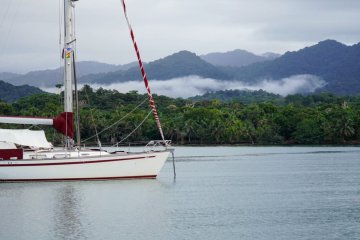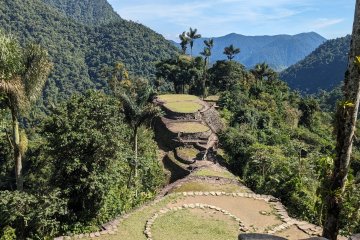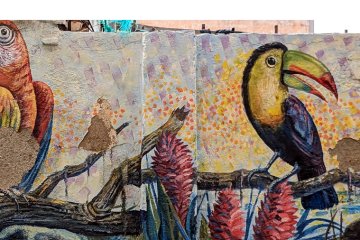After flying from Cartegena to Medellin we collected our rented car from the airport and headed into Medellin itself.
Medellin is a large town and the driving standards are not so high – compared to Europe. It’s quite common for other vehicles to change lanes directly in front of you with no indication at all. Similarly it’s quite in order to suddenly cross all 4 lanes of traffic from the inside to outside (or vice-versa) to turn at the junction just 10 metres away!
And the less said about the myriad of motorbikes, scooters, Tuk-tuks and pedestrians that appear from all sides, regardless of traffic lights or signs, the better. Did I mention the buses?
Chaos is the order of the day and it’s best to keep a very watchful eye on everything going on around you.
Many of the streets are one way, but we never did understand how you could tell, not that it made much difference to the locals. But if you did make a wrong turn it could very frustrating to get back on the right road – thank goodness for “Google Maps”.
Eventually, after a good two hours, we made it out onto the country roads in the direction of Jardín, our first stop.
We visited Jardín and Jeríco, two very charming colonial mountain towns in the mountains of Antioquias, where we spent several days.
Just getting to Jardín is a beautiful drive through green coffee plantations that stretch far across the mountainous landscape.
Jardín is a small paradise and the entrance to the village offers colourful houses built in the colonial style with a matching life. The farmers actually come to town with their on horses where they (the horses) are tied up in front of the bar.
You feel transported to a kind of Wild West. The whole village meets in the evening on the main square and there are arepas, empanadas and grilled sausages everywhere.
Smartly dressed women on the horses pose in front of the men – not the other way round.
All the people are incredibly friendly and nice.
Whilst there we rode on “la Garrucha” – this is an adventurous cable-car ride in a small gondola, which was more like a cage complete with wooden slats. This takes you across the river to the other side.
Because of the way the “car” is hauled across the valley the ride consists of a series of jerks (as the slack in the cable is pulled up) followed by a breath stopping pause before the next surge!
We opted to walk back down the steep road and across the suspension bridge into town.
In Jeríco we did a paragliding flight which was absolutely great. Simply a great experience of over half an hour to flying in silence over the hilly coffee landscape.
The journey to the small mountain village of Salamina was adventurous . The road in the broadest sense was not asphalted and covered with huge potholes and it became a real challenge for our normal car and also for John as a driver.
In the small town we stayed in an old, charming hotel, which was built in colonial style. A very narrow winding road led us the next day to Manizales and on to the “Hacienda de Guayabal”, located in the middle of a coffee-growing area.
Here we learned everything about the amount of work involved in the cultivation of the coffee plant to the coffee bean. Simply incredibly exciting and very,very labor-intensive.
Much of the coffee produced in Colombia is destined for export and ends up for the most part in the port of Hamburg. It is no surprise that coffee is so expensive.
In San Remo we spent 3 days on a small farm and hiked from there to the “Termales Rosa de Gabal” where you could relax in several hot pools and have a beautiful view of the waterfall there.
In the small town of Salento, with its fully preserved Antioqueno architecture, many colourful little houses are lined up. Here we meet quite a few tourists who are attracted by the famous “Valle de Cocora”. This pretty valley is known for its native wax palms.
The Cera palm tree is one of the largest palm trees in the world and can grow up to 60 meters high. The valley lies between an altitude of 1800 – 2400m above sea level and looks enchanting due to the surrounding mountain peaks which are often shrouded in hazy veils of mist. In this valley we had a beautiful hike. But it is noticeable that the palms here are very sparse and more than a few are missing the actual top. These palms trees are unfortunately effectively dead.
The palms, there are just 6,000 of them, can live up to 100 years. The future for this area is rather a sad one, because in 15 years there will be no more palms here. The landscape is largely used for agriculture and new palms cannot grow as the parrots which are responsible for the fertilization of the seeds, are missing.
We took an adventurous ride on an ATV into “Carbonera Valley”. Here some 600,000 palm trees still grow in the middle of forested mountains. You can hear the screeching parrots from far away. Simply a captivating and an almost untouched landscape.
Our visit to “Nevado del Ruiz”, the second highest volcano (at 5351m) in the northern hemisphere, was only possible with the car with a guide and on a dirt road. The reason was because the volcano had erupted ash just a few days before and it was too dangerous to walk around there. Even if the top was shrouded in fog, the landscape and the knowledge of the guide were very impressive.
A final part of our tour was the large city of Medellin fortunately without the rental car. The traffic is adventurous and the traffic rules as well.
The city can be explored well with the Metro (train, tram, cable car and buses) for just 3 euros the whole day as can the slums located on the slopes. The cable car rides above the city are not to be missed and here you get a pretty good impression.
One of the most famous and notorious drug neighbourhoods was and still is the “Comuna 13”. We had a great guided tour through this neighbourhood with our guide Julio.
Julio, who grew up here and experienced the drug terror, was able to give us a good background to many historical and current events associated with “Comuna 13”.
This neighbourhood has now been opened up to tourism following the expulsion of the the drug lords and terrorists in an infamous government operation “Orion”. Now the people here can earn a livelihood giving guided tours combined with street art depicting the “dark” days and eventual liberation of the area.
The houses are colorfully painted and decorated with murals (which are very famous) that tell the story of the slum dwellers. This is the only neighbourhood where the government built escalators through the narrow, winding streets. This enables the local population better access to their houses as cars cannot pass along the steep streets. But even here, the government’s commitment is not enough to really integrate the locals into the community. Education, i.e. schools, is only available in Medellin city, and this is not manageable for most of the children.
The finale of our trip was the small colourfully painted colonial village of “Guatape”. On the walls of the houses you can find beautiful three-dimensional representations of village life.
However, the city has many tourists, since every day from large tour buses arrive from Medellin full of day trippers. The city is framed by a very beautiful lake area, which you can see beautifully from the mountain “Penol” with its 649 steps to climb – a “must do” for many.
It was a great round trip through Colombia’s coffee growing area and we are pretty excited about the people and the great nature.
Back in the marina on “Maya”, and we are again greeted by the extreme heat of Cartagena.
Some days it is so hot (36 – 38C), that most activities on the boat become too exhausting and are really only possible early in the morning or after 5pm.
We have the underwater hull professionally cleaned of weed and barnacles by two friendly old guys. “Maya’s” hull and “topsides” are polished and the badly faded red “Najad” line around the cockpit is re-painted.
Of course we have to stock up for the next months in the “San Blas” islands and Panama, because there are many things that are not available there and food is very expensive.
“Maya” is now full of provisions, wine, beer, spare parts and much more…..
With our Italian friends we spend a wonderful evening in which Freddy shows me how to make ravioloi with my pasta machine. It was great fun even though it was quite time-consuming. But the ravioli filled with a spinach-ricotta-parmesan mixture were an absolute hit.
On Wednesday we will first go to “Isla Baru” and then on via the island of “Fuerte” in the direction of “Obaldia” to clear in to Panama. Today we were already at the agent and tomorrow we will hopefully get our stamped passports and the required Zarpe to enter Panama.



